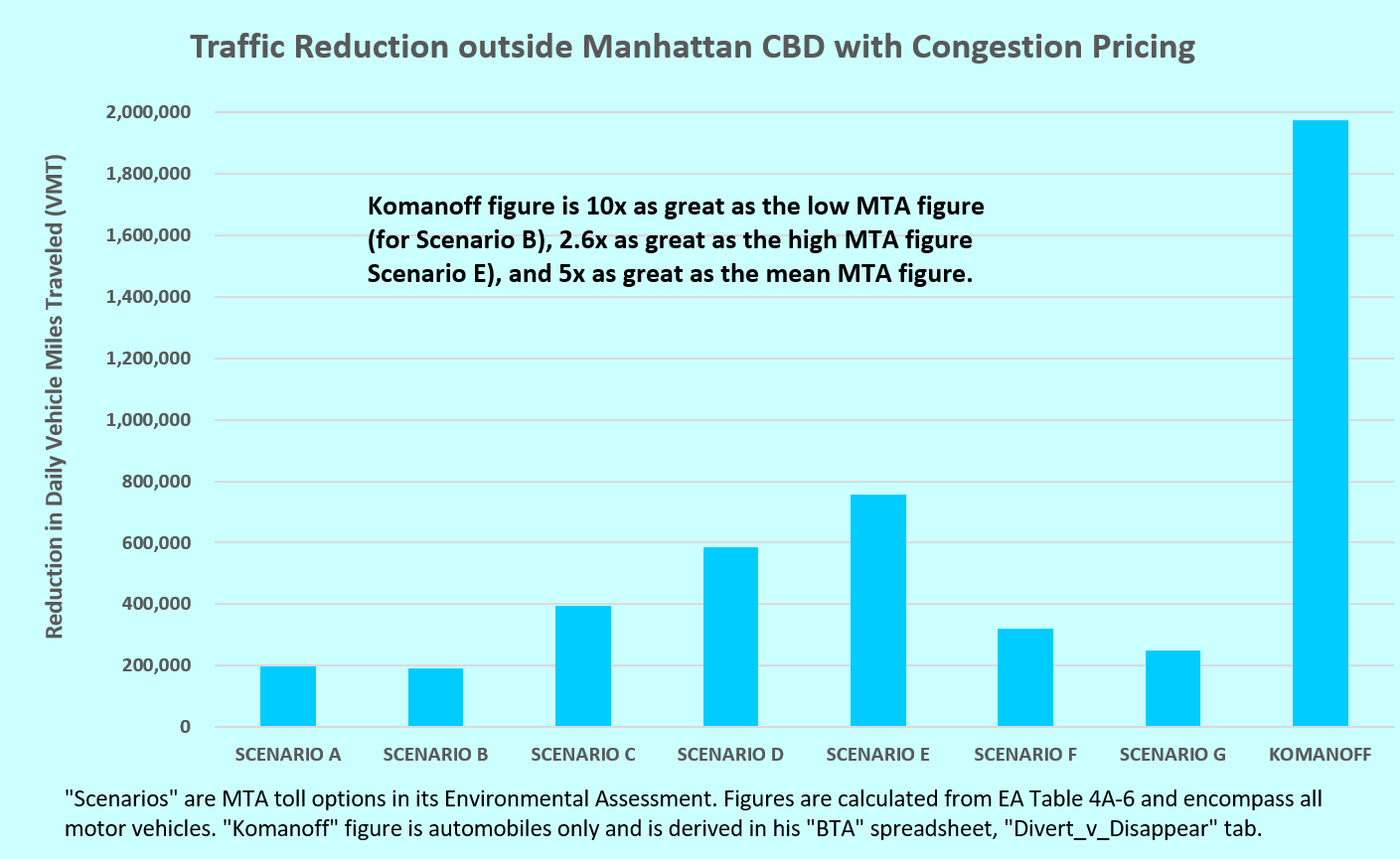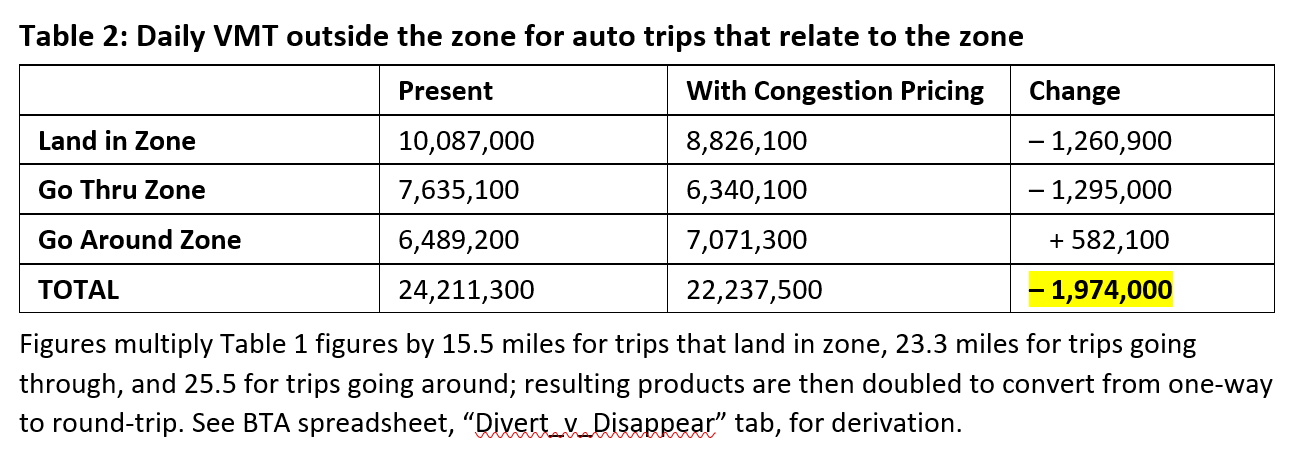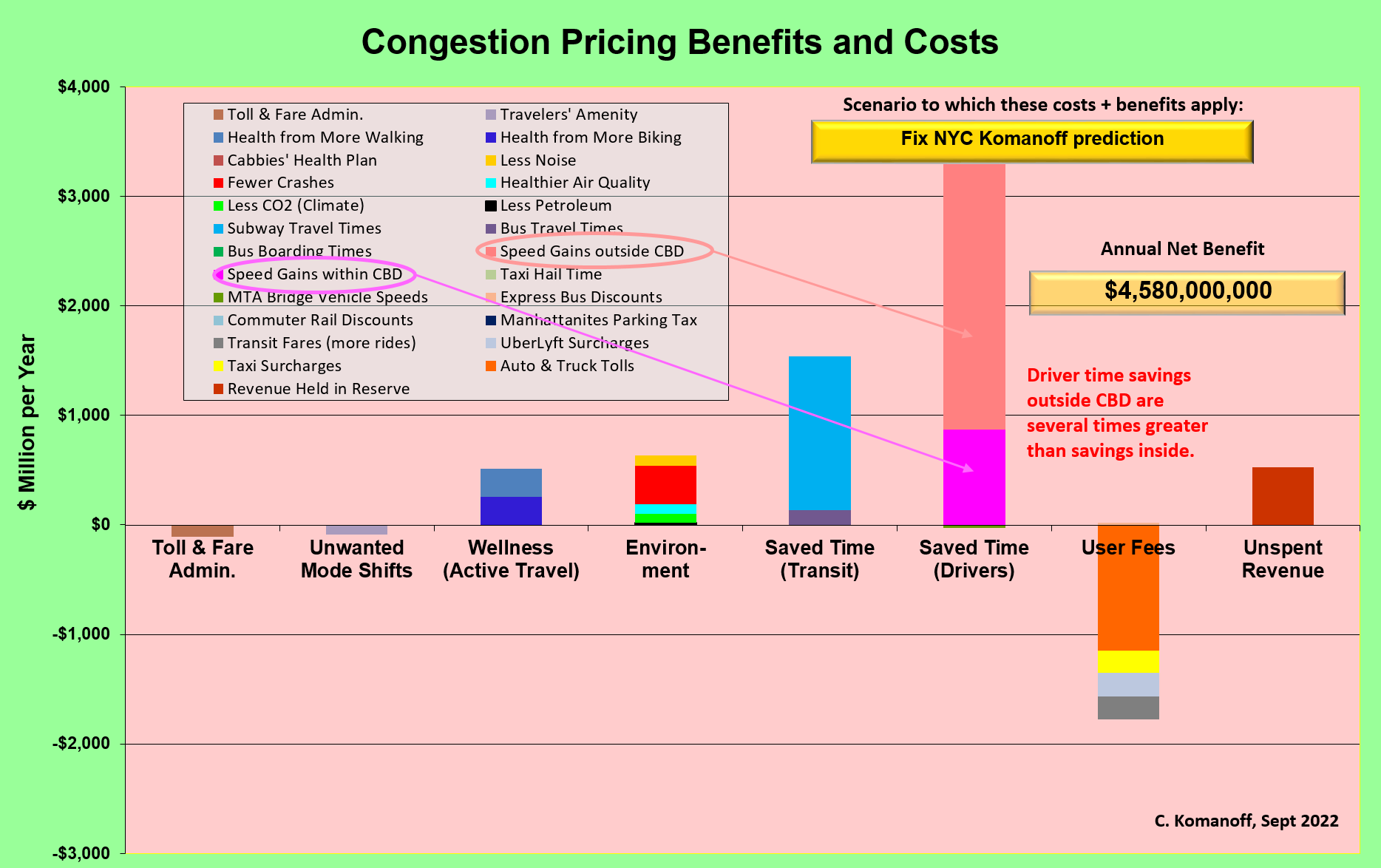
Clearer streets on the way (photo: Marc A. Hermann/MTA New York City Transit)
Damage continues to mount from the Metropolitan Transportation Authority’s bungled environmental assessment (EA) of congestion pricing.
With its sprawling, 46-volume EA, the MTA took a proven policy idea, so well-suited for New York that it was destined to bestow $10 million worth of travel-time savings to drivers across the region every day, and turned it into a dog: a money grab that will cut traffic only in Manhattan.
While that “finding” is nonsense, it has a whiff of plausibility. Congestion pricing will cause some car and truck trips that now go through Manhattan from New Jersey to Long Island to divert around the island. Some will go west to east via the Bronx, others will divert to the south, across Staten Island. But the MTA has grossly exaggerated this effect.
According to my new analysis, the authority has also understated this offsetting effect: the tolls will result in elimination of 10 to 15% of auto trips from around the region that now go to the Manhattan core, and that habitually congest the boroughs and counties through which they pass en route.
These errors add up to an average five-fold underestimate in the EA of cuts in traffic volumes outside the Manhattan core because of congestion pricing. For the bulk of the region — the four “other” boroughs plus Westchester, most of Long Island, and the closest New Jersey counties (Essex and Hudson) — traffic volumes will fall by an average of 2%, a palpable cut, rather than the EA’s nothingburger forecast of 0.4%.
Put differently, for every vehicle-mile of car traffic that congestion pricing will eliminate within the Manhattan pricing zone, eight vehicle-miles will disappear outside the zone.
Were these findings in the assessment, the storm of criticism of congestion pricing since the EA’s August 10 release would have been far less intense. Instead, as the final push approaches, congestion pricing has seemed at times to be shedding public support. And no wonder. For a wonky, seemingly newfangled scheme like congestion pricing to actually come into being, it must bring big, broad benefits, not perks for a small and relatively wealthy minority.
Making matters still worse, the face of the assessment, and thus of congestion pricing itself, soon became its forecast of more heavy trucks spewing exhaust on and around the poster child of transportation injustice, Robert Moses’ Cross-Bronx Expressway. Yet the fact is that even with such an increase, the Bronx as a whole would still enjoy slightly cleaner air due to lesser atmospheric conversion of regional exhaust into toxic particles. Even better, the shrinkage in traffic volumes promises to cut air pollution across the board as fewer combustion engines spew emissions, fewer vehicle tires are ground into airborne particulates, and trucks’ driving speeds even out somewhat with improved traffic.
The prospect of lower traffic volumes throughout the region puts the lie to the idea that only residents of Manhattan stand to benefit from congestion pricing. True, the proportional fall in traffic volumes will be most pronounced in Manhattan, but traffic volumes region-wide will shrink so much that the reductions outside the zone will far exceed the reductions within it — again, by eight-fold, per my calculations.
This finding also refutes the idea that congestion pricing is “only about the revenue.” Rather, congestion pricing will not only raise revenue to improve subway service — the economic lifeblood and equity linchpin of our city and region — it will materially cut traffic, even without crediting the “carrot” effect of better mass transit luring some trips from automobiles.

How Did the MTA Get Congestion Pricing’s Traffic Benefits Wrong?
Following the August 10 release of the MTA’s environmental assessment, I tried for weeks to ferret out the “price elasticity” in the “best practices model” (BPM) the authority used to estimate how congestion pricing will change traffic and travel.
I theorized that the BPM grossly understates the extent to which making it costlier to drive into or through Manhattan will induce drivers to “mode-switch” to public transit or carpool or give up the trip altogether. I also wondered if MTA staff running the model had mathematically misapplied price-elasticity in a way that would compound the undercount of eliminated car trips.
I came up empty. The MTA modelers ignored my entreaties to share info, and their model, a product of the age of mainframe computers, is impenetrable. However, I learned last week from a source that the BPM does not even employ price-elasticity, which translates percentage increases in trip costs into percentage decreases in trip volumes. It may instead model trip choice through the physics concept known as “impedance,” treating tolls and other trip costs in a manner analogous to increased resistance to electric current flowing through a wire.
Somehow, this got me thinking differently about the MTA’s modeling. If the big flaw in the environmental assessment was that it understated traffic reductions outside of Manhattan, I would try to calculate how congestion pricing would change “vehicle miles traveled” (VMT) in those areas.
My Qualifications to Assess Congestion Pricing
Since I am counter-posing the MTA’s congestion pricing findings with my own, I should state my qualifications to quantify congestion pricing’s impacts.
I have spent much of the past 15 years developing and updating an elaborate (“kaleidoscopic,” I like to say) Excel spreadsheet model of New York City traffic and transportation known as the Balanced Transportation Analyzer.
The “BTA,” which I continually update and keep in the public domain via this permalink, has over 80 interlocking worksheet “tabs” that are stocked with baseline travel data and connected by over 100,000 equations and algorithms. These tabs “communicate” with each other and recalculate traffic volumes and other outputs whenever users enter inputs that correspond to congestion tolls and/or dozens of other potential policy changes. Data inputs are made easily in a single tab, allowing them to be processed in minutes or even seconds, and the calculation of results is instantaneous.
The BTA’s rigor and its ability to output the impacts of policy changes such as congestion toll levels led to its being made the primary analytical tool used by New York State’s “Fix NYC” panel to scope congestion pricing in 2017-2018. (The Fix NYC panel report has been scrubbed from New York State government sites but is archived at my website; the report’s Appendix B dedicates two pages (pp 32-33) to describing and lauding the BTA.)
To my surprise, this year the MTA’s environmental assessment team used my spreadsheet to select the toll levels it then evaluated for its various tolling scenarios. (See Central Business District (CBD) Tolling Program, Appendix 4B.1, Transportation: Transportation and Traffic Methodology for NEPA Evaluation, p. 1-2.) The team did not, however, use the BTA to estimate the number of auto trips to or through the congestion zone that would be eliminated under the different toll scenarios.
My VMT Analysis of Congestion Pricing
Conceptually, my analysis was simple: I drew on the estimates in the BTA of two categories of daily auto trips: (i) those that presently “land in” the congestion zone, or central business district (CBD), and (ii) those that drive through the CBD, from west of the Hudson River (New Jersey) to geographic Long Island, i.e., the boroughs and counties east of the East River (Brooklyn, Queens, Nassau, Suffolk), or vice-versa. From the latter figure, through-trips, I was able to estimate the number of auto trips with similar origins and destinations (NJ to east of the East River, or vice versa) that drive around rather than through the Manhattan core.
How did I estimate the number of auto trips that now, without congestion pricing, drive around the zone? I compared the costs of a typical trip through the zone to one around it, accounting for fuel costs and travel time (both of which are calculated from assumed trip distances), as well as any pre-existing tolls, such as the Port Authority tolls to travel eastbound through the Lincoln or Holland Tunnel or over the George Washington Bridge.
By constructing probability distributions around these mean costs, I was able to calculate that, under present conditions, out of every 100 trips with those origins and destinations, the less expensive route is through the zone for 56 trips, and is around the zone for the other 44. I then posited that trips seeking to go from New Jersey to Brooklyn/Queens/Long Island (or vice versa) adhere to those proportions, meaning that, without congestion pricing, 56% of those trips go through the Manhattan congestion zone while the remaining 44% go around.
I then “perturbed” my baseline assumptions of driving speeds (and, thus, travel times) and tolls to reflect prospective changes from congestion pricing. The result was that the share of trips from west of the Hudson to east of the East River (or vice versa) that will find it less expensive to go around the zone increased to 48%.
Translated to trip volumes, this 4 percentage point rise in the share of go-around trips equates to 11,400 additional trips “diverting” around the congestion zone per day, as shown in Table 1 below.
That is only part of the congestion pricing equation, however. The other, and arguably more impactful part, is the outright elimination of auto trips (and not just their rerouting) as the congestion toll pushes some trips “underwater” economically, in that the net value of the auto trip for the trip-taker turns negative. These trips may switch to train, bus, subway, bike, walk, carpool, new destination, or no destination (i.e., the trip is canceled).
For my calculations I assumed that 1/8 of the auto trips that currently land in the congestion zone will be so eliminated, with a somewhat smaller fraction, 1/10, of west-of-zone to east-of-zone (and vice versa) auto trips being eliminated. The 1/8 figure is consistent with my congestion pricing modeling for trips bound for the zone; the lower 1/10 figure takes into account the poorer transit alternatives for trips that pass through or go around the congestion zone, while also reflecting the fact that trips landing outside the Manhattan core tend to create less economic value for motorists, rendering them more vulnerable to the impact of the congestion toll than trips bound for the zone itself.
These assumptions result in the before-and-after volumes of trips that pertain to the congestion zone, either by landing in it or going through or around it, shown in Table 1.
Table 1: Daily Auto trips that relate to the Manhattan Congestion Zone

Table 1 is only an intermediate result. The goal is the changes in non-CBD (non-zone) mileage for each category of trip. These are shown in Table 2:
Table 2: Daily VMT outside the zone for auto trips that relate to the zone

The literal bottom line in Table 2 indicates that congestion pricing will result in 1,974,000 fewer daily miles traveled by automobiles outside of the Manhattan congestion zone. The 582,100 daily increase in VMT from the uptick in trip diversions around the zone is swamped by the combined 2,555,900 decrease in VMT stemming from the elimination of trips to and through the congestion zone.
Now consider the projections in the environmental assessment (EA) for reduced VMT outside the zone. These range from a low of roughly 190,000 (Toll Scenario B) to a high of 760,000 (Toll Scenario E) and average 385,000 (Toll Scenarios A-G). I computed those figures directly from the Environmental Assessment’s Table 4A-6: Daily Vehicle-Miles Traveled: No Action Alternative and CBD Tolling Alternative, by Tolling Scenario (2023).
My estimate of the reduction in VMT outside the congestion zone, 1,974,000 miles per day, is 2.6 times as great as the EA’s high figure, 10 times as great as the low figure, and 5 times as great as the mean.
The Meaning of 2 Million Fewer Miles Driven Outside the Zone Each Day
My estimate, nearly 2 million fewer daily auto miles driven outside the congestion zone, is hard to grasp. To put it in perspective, consider that the combined present-day automobile VMT for New York City (outside of the congestion zone) plus most of Long Island, all of Westchester County, and the New Jersey counties closest to the CBD (Hudson and Essex) is around 100 million. (That figure is rough-calculated from Table 4A-6 in the EA.) Since most auto trips into and through the CBD originate from those districts, it’s fair to say that my estimate of just under 2 million miles a day of reduced auto VMT outside the zone equates to nearly 2% of current auto traffic in those areas.
An average 2% reduction in traffic volumes outside the congestion zone is no small thing. It promises cleaner air, quieter and safer streets, and faster, easier travel for motorists and truckers. Indeed, that promise is a key part of the bedrock on which congestion pricing advocacy has been built.
Refuting the Notion that Congestion Pricing is Manhattan-Centric
The same EA Table 4A-6 referenced above gives the MTA’s projected reductions in VMT inside the congestion zone for the seven toll scenarios. These average around 250,000 miles per day. Compared to that figure, my estimate of nearly 2,000,000 fewer vehicle miles traveled outside the zone is around eight times as great.
While there is an element of apples/oranges to this comparison (the 250,000 figure employs the MTA’s methodology whereas the 2,000,000 figure arises from mine), the contrast is so stark that it should dispel the notion that only residents of Manhattan stand to receive congestion pricing’s bounty of lesser traffic.
A Caveat
In analyzing before-and-after cost-preferences for driving through versus around the congestion zone, I chose to add only $5 to the tolls that motorists driving into Manhattan via the Holland or Lincoln Tunnels will face with congestion pricing.
That figure is intended as a rough true-up of the current Port Authority tolls to cross the Hudson River ($13.75 peak, $11.75 off-peak) to the eventual congestion toll that will likely be $15 or somewhat higher. In other words, I have chosen to assume that the congestion toll won’t be applied in its entirety on top of the incumbent Port Authority tolls.
Nevertheless, relaxing that assumption by adding $15 rather than $5 in congestion tolls to the two Hudson River tunnel crossings reduces the calculated reduction in non-CBD VMT from congestion pricing by only 10%: to a little under 1.8 million from a little under 2 million. It thus appears that my finding of substantially less VMT outside Manhattan is not terribly sensitive to my assumption that motorists crossing into Manhattan via the Port Authority tunnels won’t face the entire congestion toll as an increment in the price of their trip.
An Invitation
My key result, that congestion pricing will shrink daily VMT outside the congestion zone by nearly 2 million miles, is of course an artifact of assumptions as to toll rates, the value of motorists’ time, distances covered, highway and street speeds, etc.
I invite readers to input their own assumptions and see how the calculated VMT result changes. Unlike the MTA’s Best Practices Model, my BTA spreadsheet is in the public domain and is easily manipulable for the sake of sensitivity analysis. As noted the BTA is available for downloading (17 MB Excel spreadsheet, go to “Divert_v_Disappear” tab).
In Closing
Congestion pricing was always going to have to be fought for, every step of the way, not only to enact the legal authority, as was accomplished in the New York State Legislature’s March 2019 budget bill, but to actually put it into practice. We advocates were ready to help ensure that the congestion toll program was put into fruition. However, we should not have had to help beat back the tidal wave of opposition that has engulfed the program since the MTA’s environmental assessment was released, which arose largely from the assessment’s faulty modeling and unfounded results.
Those results should be withdrawn. Contrary to the MTA’s assessment, not just the Manhattan core but the entire city and region are poised to enjoy material reductions in traffic volumes and, with them, the panoply of economic and quality of life benefits that congestion pricing proponents have long touted to our fellow New Yorkers: quieter, safer streets; more accommodating environments to walk and bike; cleaner air; speedier bus service; easier goods logistics and delivery; and, above all, improved travel times for users of automobiles, yellow cabs, ride-hail services, buses, and trucks.
My own modeling puts these “net” benefits (“net” in the sense of deducting the tolls paid by motorists, the cost to install and operate the tolling infrastructure, and the lost value of the trips that the new toll will “price off the road”) at some $4.5 billion a year — around $12.5 million a day. Denying that benefit, as the MTA’s environmental assessment essentially does, by grossly undercounting traffic reductions across the city and region, qualifies as an “own goal” of monstrous proportions. I call on the MTA to reboot its analysis and finish the job of leading congestion pricing through the bureaucratic wilderness and to fruition as soon as possible.

***
Charles Komanoff, long-time New York policy analyst and environmental activist, has been quantifying congestion pricing's costs and benefits for 15 years. On Twitter @Komanoff.
***
Have an op-ed idea or submission for Gotham Gazette? Email This email address is being protected from spambots. You need JavaScript enabled to view it.




